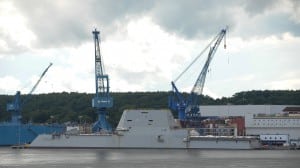
BATH, Maine--The Navy’s new Zumwalt-class (DDG-1000) destroyer rests docked at the Bath Iron Works shipyard here in southern Maine, with its size--the largest destroyer ever built-- readily apparent along with its slick, stealthy and sharp angular design.Also imposing are the two massive guns on the ship’s deck, a new advanced system designed to strike targets more than 60 miles away as part of the Navy’s planned land-attack mission.The interior of the ship is a different scene. There, construction, electrical and…













